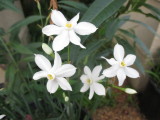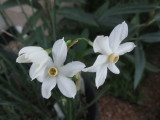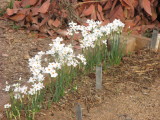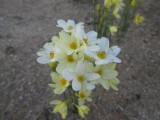The color on the all white clone of N. obsoletus appears to have clarified. Compare the picture posted a few days ago with that from this morning.
A row of N. obsoletus now in peak bloom. Sometime I should post pictures of some of the wild forms just to show how scruffy they can be.
Another comparison. The first time I made N. x pezlerae (N. miniatus x N. cavanillessii) I used what I thought were well formed flowers but then I remade it with better formed flowers. Look at the difference the “improvements” have produced. The improved form was also posted a few days again but I show it again for comparison. Take home lesson is that not all forms of the species are equivalent when hybridizing. These hybrids really know how to proliferate.
Narcissus broussonetii is one of the larger autumn flowering daffodils. I think it is just a mutation of N. papyraceus.
Harold







Hi Harold,
I’m amazed by the pictures you and Theo are posting.
Because of the barrier between paperwhites and colored tazettas I think the white obsoletus is particularly interesting. In my wild fantasies I imagine such a plant is necessary to breed pink entirely within the tazetta section.
In my experience, when you cross paperwhites with each other you get more paperwhites with glaucous foliage and when you outcross you get plants with green foliage. I had a Pearl type tazetta (presumably 2 parts paperwhite and one part tazetta) that usually breeds as if it is a paperwhite, something Bill Welch reported decades ago, but which sometimes produces plants that include tazetta characteristics. These have some fertility and they have green foliage. Here the paperwhite broussonetii hybrids have poor fertility and green foliage so I would guess they are not very close.